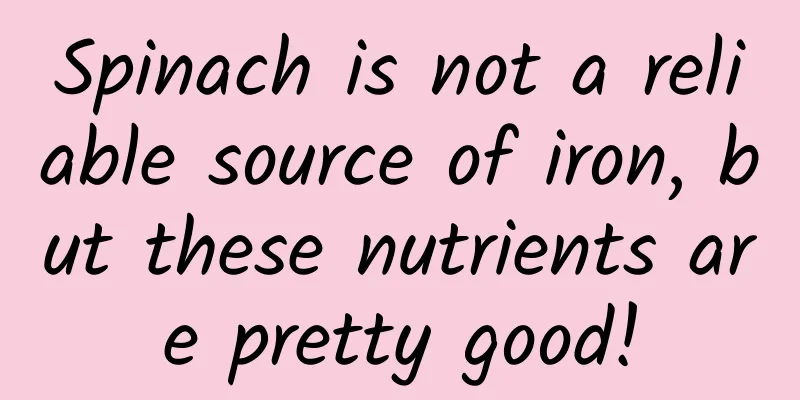Spinach is not a reliable source of iron, but these nutrients are pretty good!

|
Author: Xue Qingxin, registered dietitian Reviewer: Zhang Yu, researcher at Chinese Center for Disease Control and Prevention When it comes to "what to eat to supplement iron", many people will think of spinach first. But is spinach a reliable iron supplement? What are the most nutritious properties of this vegetable? Figure 1 Copyright image, no permission to reprint 1. Spinach is not a reliable iron supplement "Eating spinach can supplement iron" is an old rumor among the people. But in fact, it is not reliable to supplement iron by eating spinach. Whether in terms of iron content or the form of iron, spinach is not a good choice for iron supplementation. Spinach contains 2.9 mg/100 g of mineral iron, which is not considered high among vegetables. Although it is 2.2 times the iron content of pakchoi, it is not as high as celery, which contains 6.9 mg/100 g of iron[1]! There are many vegetables that we often eat, which actually have higher iron content than spinach. So from this perspective, the little iron in spinach is really not an advantage. Figure 2 Copyright image, no permission to reprint In addition, the iron in spinach is non-heme iron, and the body's absorption rate of this type of iron is only 2% to 20%[2], which is very low. If you pair it with some fruits and vegetables rich in vitamin C, the absorption rate can be increased, making a small contribution to iron supplementation. However, the iron in animal foods is generally heme iron, and the body's absorption rate of this type of iron is 15% to 35%[2]. For example, pork liver, red meat, and clams have a high absorption rate and are more suitable for iron and blood supplementation. 2. Spinach has good nutrients Although you can't expect to supplement iron by eating spinach, it doesn't mean it has no advantages. Spinach still contains many good nutrients. β-carotene: β-carotene can be converted into vitamin A in the human body, which is not only beneficial to eye health, but also helps prevent dry eye syndrome, night blindness and cataracts. Literature shows that people with high serum β-carotene levels have a lower incidence of cataracts than those with low serum β-carotene levels [3]. According to data from the U.S. Department of Agriculture Nutrition Database, the β-carotene content in spinach is as high as 5630 micrograms per 100 grams [4]. Although not as high as that in carrots, it is worse than leeks, Chinese cabbage, coriander, etc. For office workers who need to face mobile phones and computers frequently, it is recommended to eat spinach frequently. Lutein and zeaxanthin : Lutein and zeaxanthin can reduce the risk of age-related macular degeneration and cataracts[5]. The content of lutein and zeaxanthin in spinach is 12,200 micrograms per 100 grams, which is nearly 48 times that of carrots[4]. Potassium: Adequate potassium is important for maintaining normal blood pressure and heart rate. According to the Chinese Food Composition Table, the potassium content in spinach is 311 mg/100 g [1], which is 1.2 times the potassium content in bananas. It is more suitable for people who need to stabilize blood pressure. Folic acid: Folic acid is also called vitamin B9. The total amount of folic acid in spinach is 194 micrograms per 100 grams, while Chinese cabbage only contains 66 micrograms per 100 grams [4]. Folic acid deficiency can lead to elevated homocysteine levels in the body, increasing the risk of cardiovascular and cerebrovascular diseases. For pregnant women, folic acid deficiency may lead to anemia, miscarriage, premature birth, gestational hypertension, and even neural tube defects in the fetus, such as cleft lip and palate, spina bifida, and anencephaly [2]. However, folic acid is a water-soluble vitamin that is easily soluble in water and easily lost during cooking. Therefore, for special groups, such as pregnant women, in addition to increasing spinach intake in the diet, it is also recommended to take folic acid supplements. Dietary fiber: Adequate intake of dietary fiber can not only increase satiety, but also promote gastrointestinal motility and prevent constipation. The total dietary fiber content of spinach is 2.2 grams per 100 grams, which is twice that of Chinese cabbage[4]. In summary, although you can't expect to supplement iron by eating spinach, the above nutrients are still good. Spinach is still a good vegetable worth recommending. However, spinach contains a high amount of oxalic acid. Oxalic acid combines with nutrients such as calcium and zinc in the human body to form oxalates such as calcium oxalate and zinc oxalate, which reduces the absorption and utilization rate of calcium and zinc. In addition, excessive intake of oxalic acid can also increase the risk of kidney stones[6]. But this is not a problem. You can remove most of the oxalic acid by blanching the spinach before eating. However, don't blanch it for too long. Otherwise, not only will the nutrient loss increase, but the spinach leaves will also change color due to prolonged heating, affecting the appearance. Overall, spinach is a relatively nutritious vegetable, especially helpful in stabilizing blood pressure and eye health. References: [1] Yang Yuexin. Chinese Food Composition Table 6th Edition Volume 1[M]. Peking University Medical Press, 2018 [2] Yang Yuexin, Ge Keyou. Chinese Nutrition Science Encyclopedia 2nd Edition (Volume 1)[M]. People's Medical Publishing House, 2019 [3] Cai Xiaozhan, He Yinfeng. Research progress of β-carotene[J]. Agricultural Products Processing (Journal), 2005(8):27-30. [4] USDA Nutrient Database [5] Li Dajing, Pang Huili, Liu Chunquan. Research progress on the protective effect of lutein and zeaxanthin on the eyes[J]. Jiangsu Agricultural Science, 2013, 41(9): 1-4 [6] Tang Chuanhui. Effects of different cooking methods on the nutritional quality of spinach[J]. Modern Food, 2018(21):53-55,64. [7] Zhang Deguang, Zhang Xiaoli. Effect of cooking on oxalic acid content in spinach[J]. Food Research and Development, 2009, 30(5): 39-41. |
>>: Why do some leaves turn yellow and some turn red in autumn?
Recommend
Facial recognition is so easy to fool, will my money be stolen?
AI face-changing used to only bother celebrities,...
Give the tea tree a massage and it will give you its fruits!
When it comes to oil-tea, the first thing that co...
How to analyze user thinking and do good brand marketing?
In the past, everyone has always talked about tra...
Mini Program promotion model and marketing plan, how to promote and attract traffic for Mini Program?
This is the best of times, and the worst of times...
Xiaohongshu's popular articles routines and rules
The rare popular articles with tens of millions o...
A highly profitable naming project, Douyin leads to 300+ orders, selflessly sharing it with you
Today I will share with you a highly profitable m...
Hydrogen energy, it’s not easy to say I love you
Excerpted from: Inside and Outside the Classroom ...
What are the creative writing techniques for Baidu bidding accounts?
In the bidding process, creative writing is essen...
APP promotion: digging into those niche promotion channels (there is always one that suits you)
There are many articles about App promotion chann...
Take stock of the brand marketing strategies spawned by anxiety!
• Introduction• The tiny cracks in human nature a...
The sun just erupted an X-class flare. What impact will it have on the earth?
X-flares are the most powerful solar flares. The ...
How to write a title with high click-through rate and high forwarding rate?
Say it in advance Create suspense, combine hot sp...
A complete App operation and promotion plan!
1. Concept of App operation and promotion Quoting...
Operational promotion: 4 general methods and techniques to increase followers!
Today, we will share 4 general tips for increasin...
How to do a good job in the market for a new APP: cheating, deceiving, kidnapping, deceiving, stealing
In the mobile game market, if a marketer wants to...









